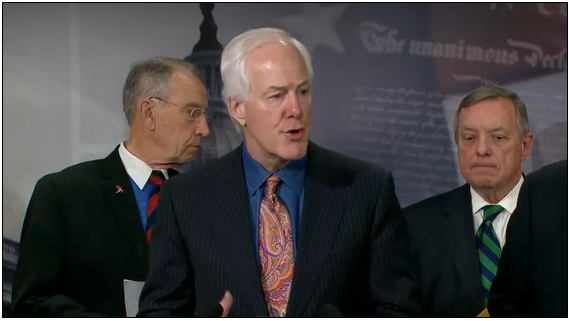By Natalia Castro
There is a well-coordinated prison break going on in your city, planned by politicians and disguised as S.2123 or the so-called Sentencing Reform and Corrections Act of 2015. Under the term “criminal justice reform” Senators want you to believe our justice system is being changed, in reality the problem is being released into your backyard. Effectively closing prisons, and turning your previously safe neighborhoods into one.
The 2015 bill doubles down on the 2010 Fair Sentencing Act by allowing those already convicted of trafficking large quantities of drugs to be released into the general public. The Justice Department has justified releasing thousands of sophisticated and violent drug traffickers under the theory that because time has passed and the criminal justice system has been strict, the offenders deserve a break. This backwards logic allows those most angered at society, already demonstrating their impact, to be released.
Sen. John Cornyn (R-Texas) sees the greater problem to be high prison costs and sees releasing more criminals as the solution. He hopes to build on prior ineffective legislation as a form of bipartisan outreach rather than focusing on obvious inefficiencies and dangers.
“We ensured that violent criminals, and those who have been hardened by a life of crime, will stay in prison while addressing the ballooning prison population,” Cornyn said of recent changes to the legislation, which still have not been released publicly.
But despite Cornyn’s assurances, the Sentencing Reform and Corrections Act is simply an extension of the Fair Sentencing Act — more of the same.
The Act shaves even more time off minimum sentencing guidelines — even of violent criminals who were convicted of assault with sentences that carried less than a maximum of ten years. Thus, the legislation retroactively reduces sentences and releases thousands of criminals, endangering the general public.
Allowing violent offenders to be released early is not only problematic but dangerous. Senator Cornyn likes to believe a similar version of this act worked in Texas, but put simply, it did not.
While Texas did experience less individuals in prisons from 2011-2014 following implementation, the state’s own Legislative Budget Board’s February 2015 report on Statewide Criminal and Juvenile Justice Recidivism and Revocation Rates noted levels of rearrest also grew considerably. The report explains this is true for the most violent offenders: “The most prevalent offense for which the fiscal year 2011 released offender were rearrested was as offense categorized as violent, at 28.7 percent. The average time out of custody before rearrest was 14 months for all released cohorts.”
Stating these reforms worked in Senator Cornyn’s home state is a mischaracterization of the evidence available. Yes, there were less overall individuals in prison — because they were being released sooner and pushed in and out of the system — only hurting more law abiding citizens each time when the released criminals then committed violent crimes.
Expanding these numbers onto the national level becomes terrifyingly simple. The Act is expected to release over 7,000 career criminals, including about 5,800 which were previously ineligible with its new expansion of the Fair Sentencing Act. With a 77 percent standard recidivism rate amongst released prisoners this means 5,390 criminals released onto the streets will simply recommit crimes. If we assume a standard 25 percent of those are violent, a gracious number less than Texas reported, nearly 1,350 of the early-released criminals will commit violent crimes.
Criminal justice reform is not achieved by reducing prison costs, as if taxpayers were just walking piggy banks. They are human beings, Americans, who could be killed by violent early-release offenders. Emptying federal prisons is a mistake that many families will tragically come to regret.
Natalia Castro is a contributing editor at Americans for Limited Government.








